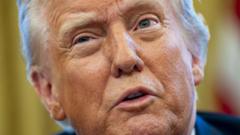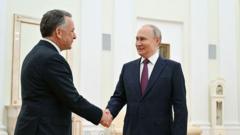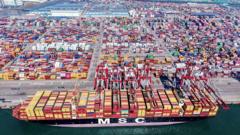**Amidst ongoing trade negotiations, President Trump faces critical decisions about tariffs as global markets recalibrate following his recent postponement of duties on North American allies.**
**Trump's Trade Strategy: A Temporary Breather?**

**Trump's Trade Strategy: A Temporary Breather?**
**President Trump delays tariffs amidst complex negotiations with Canada and Mexico, but the trade battle looms.**
In a significant development over the weekend, President Donald Trump announced his plan to impose sweeping tariffs on allies Canada and Mexico, alongside new duties on Chinese imports. This decision reflects a pivotal moment in Trump’s presidency, where trade—previously overshadowed by immigration and other issues—has now taken center stage.
Upon taking office, Trump’s administration appeared to prioritize a host of other contentious policy areas including immigration reform and changes to the federal workforce. However, the delayed implementation of 25% tariffs on Canada and Mexico has reignited discussions on trade deficits with both countries, a recurring theme in the president's rhetoric.
Despite the temporary pause in tariffs for negotiations, Trump remains fixated on trade deficits as a significant concern. His viewpoint suggests that no combination of improved border security or drug seizures could fully assuage his frustrations, thus keeping the threat of tariffs alive. Moreover, the president regards tariffs not only as leverage for achieving political objectives but also as an essential source of federal revenue—indicating that long-term implementation might be necessary to meet fiscal goals.
The announcement of tariffs sent shockwaves through global financial markets, raising fears of a multi-front trade war between the United States and its critical economic partners. However, after discussions with Mexican President Claudia Sheinbaum and Canadian Prime Minister Justin Trudeau, Trump postponed the tariffs, at least temporarily. While the duties on China are already in effect, the more significant implications of trade tensions with Canada and Mexico could have caused severe disruptions given their collective trade value exceeding $1.57 trillion this year.
In evaluating the concessions made, Canada has pledged to enhance border security and appoint an anti-crime chief, while Mexico's commitments mirror previous troop deployments aimed at drug enforcement initiatives. These steps may not suffice to satisfy Trump's demands come the next evaluation of trade relations in approximately a month.
Trump's ability to assert strong pressure on Canada and Mexico could yield concessions, but optimism among investors has waned, suggesting they perceive his approach as more bluster than actual policy enforcement. The current climate indicates that negotiations could yield diminishing returns if Canada and Mexico feel the tariffs are more threat than reality.
At this crossroads, Trump faces critical decisions: to either abandon his expansive trade strategies atypical of modern trade policies or to persist in a new America-centric trade framework, despite potential short-term economic backlash. The complexity of trade negotiations highlights a moment of reckoning for Trump, as he finds himself balancing national revenue generation against sustained global alliances.
As negotiations unfold, the coming weeks will be crucial in determining the direction of U.S. trade policy and the future of its relationships with key trading partners.



















